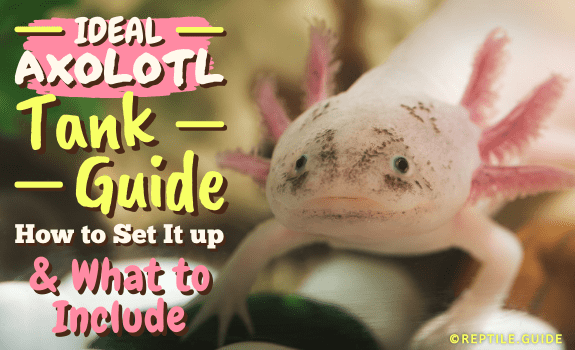Axolotls spend all of their time in their enclosures. As an axolotl owner, it’s your responsibility to give them a habitat that keeps them happy and healthy.
Owning an axolotl requires experience in keeping fresh-water aquariums. The most important parts of your axolotl’s tank are their water quality and temperatures.
If you’re ready to be an axolotl owner, we’re here to help you successfully set up your new tank.
In this article, you’ll find out:
- The correct water parameters
- If axolotls can have tank mates
- What size aquarium your axolotl needs
- How to set up and maintain your axolotl tank
In This Article
Axolotl Tank Size
The minimum tank size for an axolotl is 15-20 gallons.
Add 10 gallons per axolotl if you plan to keep more than one together. You’ll want to give them plenty of space to get away from each other.
Ground space is more important than depth.
Your Mexican walking fish will spend most of its time “walking” on the bottom and won’t need a lot of room to swim around.
Water depth should be at least the same as the length of your axolotl. Some owners even double the length.
Expert Tip: It’s easier to maintain stable temperatures and water chemistry in larger tanks with higher volumes of water.
Axolotl Tank Water Temperature
Keep your axolotl tank temperature between 60-65°F.
Water temperature is one of the most important elements of your axolotl’s enclosure.
An axolotl’s natural habitat is in high-altitude lakes with cold water.
If your axolotl’s water is too cold, their metabolism will slow down. This leads to a decreased appetite and sluggishness.
However, they’re sensitive to high temperatures and can easily become stressed. The temperature should never exceed 75°F.
The warmer the water is, the less oxygen it can hold. Adequate aeration is crucial for healthy axolotls.
High temperatures can cause health problems and even death.
Water Quality
The water values in your tank are crucial for your axolotl’s health.
An axolotl’s permeable skin leaves it vulnerable to infections.
The most important values:
- pH – pH, or the acidity of water, needs to be between 6.5-8.
A pH of 7.5 is ideal.
- Hardness – Water hardness, or the amount of dissolved mineral salts, should be between 100-200 ppm.
Axolotls do well in water that’s slightly hard. Your tap water may already be the correct hardness.
If your water is too hard, you can boil it and allow it to cool. Boiling removes some dissolved salts.
- Ammonia, Nitrate, Nitrite – Ammonia and nitrite levels should always be 0 ppm.
These elements are toxic to axolotls, so you’ll need to test for them regularly.
Nitrate isn’t as risky. It can fluctuate a little, but no more than 20 ppm.
High pH levels increase ammonia levels. Monitor your tank’s pH regularly to avoid dangerous conditions.
You can buy test kits for all of these water conditions online or at your local pet store.
Axolotl Tank Mates
Axolotls aren’t social animals and don’t require tank mates.
It’s possible to house axolotls together but is easiest to keep them alone.
Other Axolotls as Tank Mates
Before putting axolotls together there are a few things to consider:
- Only house axolotls together that are the same gender, or you’ll get babies.
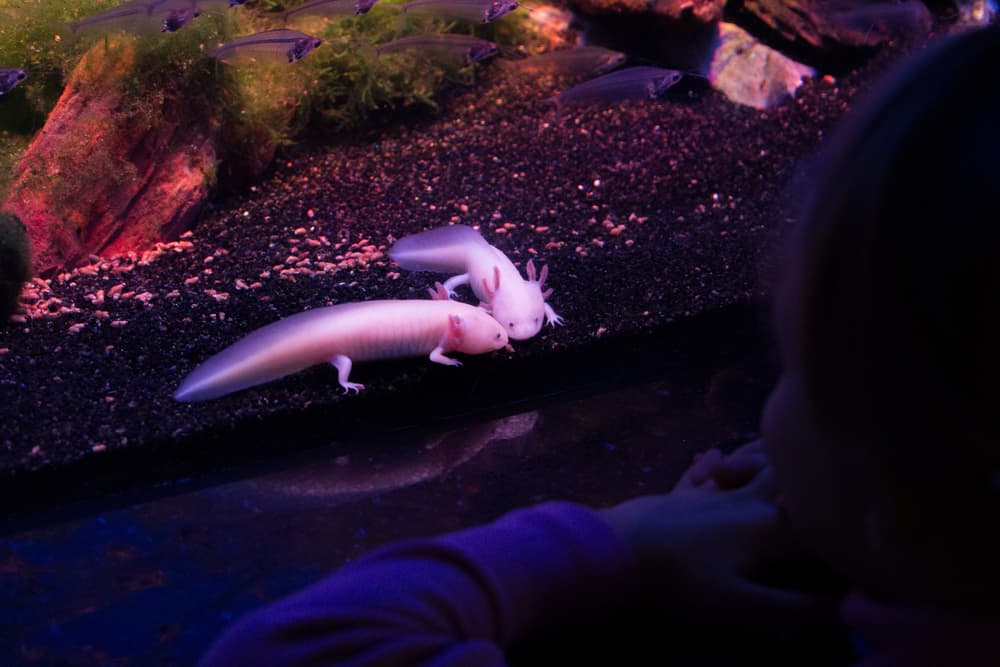
- Axolotls can bite off the limbs or gills of their tank mates. Even though they can regenerate limbs, it’s stressful for them.
- Keep in mind that adding more axolotls to your aquarium will create more waste and increase ammonia levels.
- You’ll need to increase your tank size by an extra 10 gallons per axolotl. Give them plenty of hides and space to get away from each other.
- They’re carnivores. It’s common for larger axolotls to eat a smaller axolotl tank mate. Young axolotls are especially prone to cannibalizing each other.
Pro Tip: Giving your axolotls their own space during feeding times can reduce the chance of accidents.
Fish as Tank Mates
Keeping axolotls and fish in the same tank is tricky.
Reasons we don’t recommend housing them together:
- You’d need to find fish that can withstand the same water parameters.
- It’s common for fish to bite axolotls, and even mistake their external gills for food.
- Axolotls are opportunistic carnivores and will eat anything small enough to fit in their mouths.
- Fish carry parasites and diseases that are harmful to axolotls. Putting fish with your axolotl requires a 30-day quarantine first.
Fish are part of their diet in the wild. Your axolotl is likely to eat any small fish you add to the aquarium.
Axolotl Tank Decor
A decorated aquarium not only makes it more enjoyable for you, but it keeps your axolotl happy.
Hides are the most important decor for your axolotl tank.
Axolotls are easily stressed. A dark hiding spot will help them feel more comfortable in their homes.
You’ll need at least one hide per axolotl.
Hide options are endless. Popular choices include:
- Jars
- PVC pieces
- Cichlid rocks
- Terracotta pots
- Artificial aquarium hides
Be sure that your axolotl won’t get trapped in or under them, and that there are no sharp pieces.
Other axolotl aquarium decor options:
- Rocks – Rocks are decorative and functional. Your axolotl will love walking on and hiding in them.
Certain rocks release minerals that can be harmful to axolotls. Rocks high in calcium can alter pH levels and water hardness.
Look for aquarium-safe rocks with smooth edges to avoid injuring your axolotl’s delicate skin.
Make sure they’re too big to fit into your axolotl’s mouth to avoid choking or impaction.
Slate rock and round rocks are popular choices for aquariums.
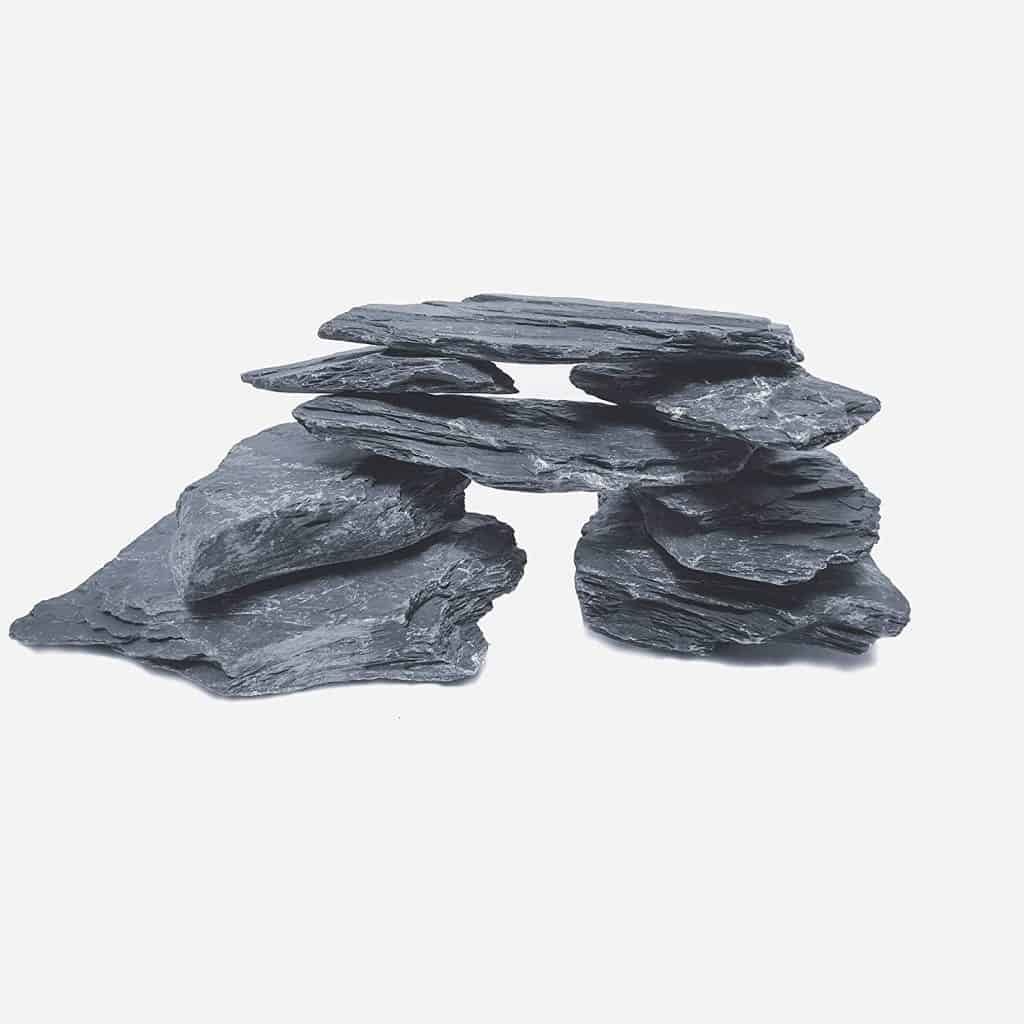
- Plants – Live or fake plants help create a more natural environment for your axolotl.
Live plants have the added benefit of increasing water quality.
- Driftwood – Add smooth pieces of driftwood to give your aquarium a more natural look.
It can also provide a place to anchor plants.
Plants for Axolotl Tank
Adding plants to your axolotl tank has considerable benefits.
Live plants:
- Add oxygen to the water.
- Are more aesthetically pleasing for you.
- Block out light. Axolotls prefer low-light environments.
- Help the nitrogen cycle by absorbing ammonia, nitrate, and nitrite.
- Create more hiding places for your axolotl, which lowers stress levels.
It’s somewhat difficult to find plants that thrive in an axolotl tank. You need something that can withstand colder temperatures and low light.
Be careful about quickly removing any dead plant material from your aquarium. They can increase ammonia and nitrite levels, which are dangerous to your axolotl.
Keep in mind that axolotls like to dig. Any plants in your substrate aren’t likely to stay there.
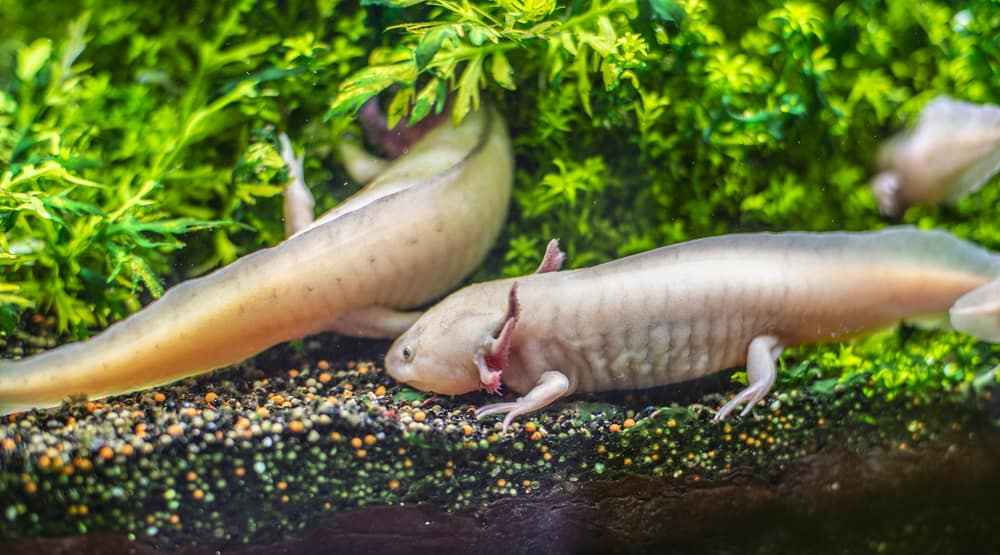
The best live plants for axolotl tanks:
- Elodea – Also called waterweeds, these plants will grow almost anywhere.
They’re easy to maintain and can survive a low-light, cold water environment.
Elodea can grow free-floating or rooted in substrate.
- Anubias – Anubias come in many varieties.
They’re popular aquatic plants for beginners because they’re slow-growing and resilient.
Attach them to driftwood or other furniture with their roots exposed.
- Java Fern – Java ferns grow slowly and are easy to care for. They prefer low-light.
You’ll need to attach ferns to furniture in your tank. They work well in aquariums without substrate.
- Hornwort – Hardy plants that can withstand very cold temperatures.
Hornwort quickly grows tall. You’ll have to trim it regularly, but it provides great shelter and shade. It can grow free-floating.
- Java Moss – Java moss looks attractive and is easy to grow and maintain.
It will grow on any surface, with or without substrate.
- Duckweed – A popular floating plant that’s great for blocking out light.
Duckweed grows very quickly.
- Marimo Moss Balls – Very popular among aquarium owners.
They can tolerate cold temperatures and low light.
They grow slowly and require minimal upkeep.
Moss balls come in different sizes, make sure they aren’t small enough for your axolotl to swallow.
If you don’t want the maintenance of a live plant, you can use fake plants instead.
Your axolotl will still love resting on and hiding in fake plants. The best fake plants are non-toxic, silk plants.
You can use plastic plants, but make sure they don’t have any sharp corners or edges.
You’ll have to keep fake plants clean, but you won’t need to worry about keeping something else alive.
Some owners use a combination of live and fake plants.
Axolotl Tank Setup
Setting up the perfect habitat for your axolotl takes time, but it will be well worth it.
A step-by-step of putting your tank together:
- Buy an aquarium appropriate for your axolotl.
- Wash the aquarium and any decorations and furniture with warm soapy water. Rinse well.
- Add substrate (optional).
- Arrange any furniture and decorations.
- Treat tap water with a water conditioner.
- Partially fill the aquarium with water.
- Add plants.
- Finish filling with water.
- Cycle the tank.
- Monitor conditions.
- Add your axolotl.
Purchasing an Axolotl Tank
You can purchase a standard aquarium online or in your local pet stores.
For one axolotl, look for a 15-20 gallon aquarium at a minimum. Increase that by 10 gallons for every additional axolotl.
Young axolotls can start in a 10-gallon tank, but you need to upgrade them as they get bigger.
Axolotls can jump, so your tank needs a secure lid. A basic mesh lid works just fine.
Some aquarists like aquarium hoods with lights. These are okay to use, but don’t allow for as much cooling as a mesh lid.
Where to Put Your Axolotl Tank
The best place for your axolotl tank is in a dim room with air conditioning.
Ideally, you’ll find a spot that is the same temperature year-round. This will help you avoid using heating or cooling devices.
Keep the tank away from windows and air vents to avoid direct sunlight and temperature fluctuations.
Avoid placing the tank near any devices that give off heat or create a lot of noise.
Substrates
Choosing the right substrate for your axolotl is more important than you might think.
Axolotls are bottom-dwellers and spend most of their time on the floor of their aquarium.
You’ll want a substrate that is easy to maintain and safe for your axolotl.
Intestinal blockages caused by inappropriate substrates are common.
Axolotls will swallow inorganic materials. This happens frequently while they’re eating, but also out of curiosity.
The best substrates for axolotl tanks:
- Sand – Fine sand is safe, looks nice, and allows your axolotl to dig and burrow.
The only downside to sand is that it’s harder to clean and maintain.
- Rocks – Rocks give your axolotl something to grip while walking across the bottom of the tank.
Uneaten food and poop will fall between the rocks, making them difficult to keep clean.
They need to be larger than your axolotl’s head and shouldn’t have any sharp edges.
Use aquarium-safe stones like polished round rocks for a more decorative look.
Large pieces of slate rock are popular alternatives to substrate. They’re easy to move around for cleaning and give your axolotl a textured foothold.
- Bare floor – A tank without substrate is the easiest to keep clean.
A downside of leaving the tank bare is that your axolotl won’t have footholds and can slide around more.
Some experts argue that this creates more stress for your axolotl.
It also doesn’t allow them to express natural behaviors like digging and burrowing.
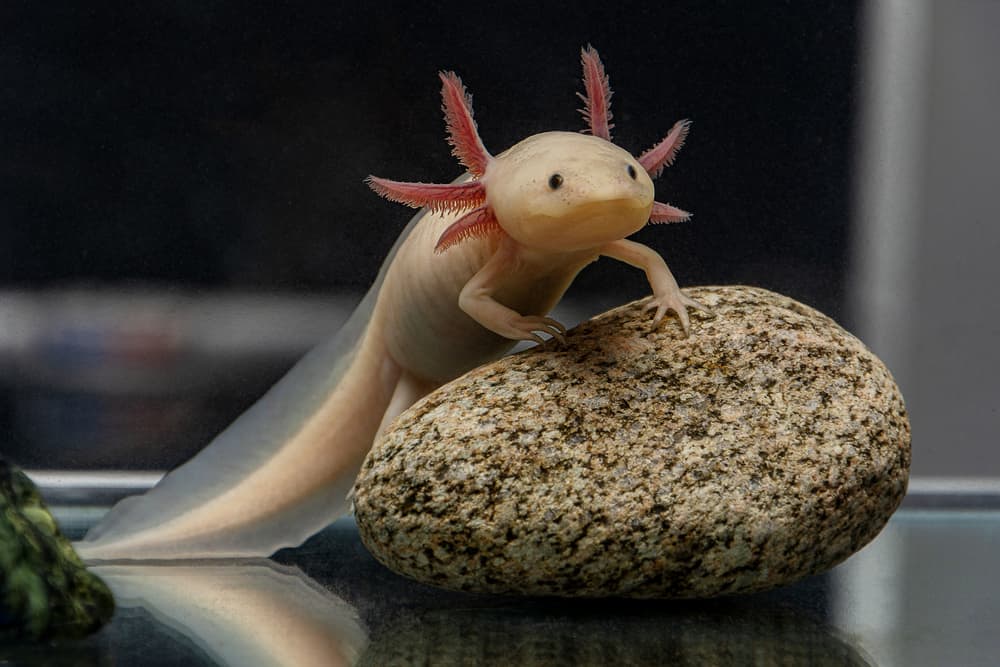
Some keepers also use ceramic tiles.
You aren’t limited to just one option. Combine different substrates to enrich your axolotl and give them choices.
Substrates that you SHOULDN’T use include:
- Gravel
- Marbles
- Pebbles
- Coarse sand
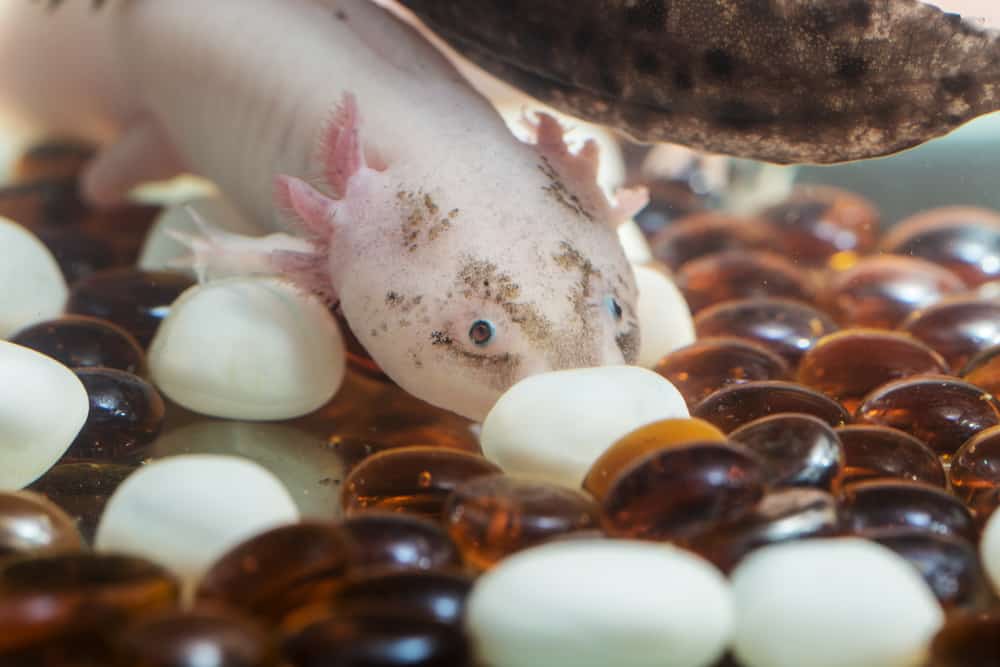
Hardware
Important materials to consider when setting up and maintaining your axolotl tank include:
1. Lights – Axolotls don’t need special lighting.
They prefer low-light enclosures.
Bright lights are stressful for axolotls. If it’s too bright, they’ll spend all of their time hiding.
Use dim LED lighting or no lights.
Make sure you provide your axolotl with plenty of dark hiding spots if you need specific lighting for plants.
2. Filters – You don’t need a filter for axolotls. Some keepers choose to go without.
If you decide not to use a filter, you’ll have to do more daily maintenance to keep your tank clean.
Filters will greatly reduce the amount of time you spend maintaining your tank.
When choosing a filter you’ll need to consider the size of your aquarium and how many axolotls you’ll have.
More axolotls mean more waste output. The filter needs a strong biological filtration system to maintain ammonia and nitrite levels.
You’ll need a slow filter with a weak flow. Axolotls prefer slow-moving water. Strong currents are too stressful for them.
Your best filter options include sponge filters, canister filters, and hang-on filters.
3. Thermometers – A good thermometer is essential for keeping an eye on water temperatures.
4. Cooling systems – Cooling systems are a good investment if you aren’t confident that you can keep your axolotl’s water temperature between 60-65°F year-round.
You can use cooling fans, Peltier coolers, or air stones/bubblers. You can also submerge a frozen water bottle in your tank for a quick solution.
Adding Water
You can use tap water treated with water conditioners that remove chlorine and chloramine.
Chlorine and Chloramine will ruin the nitrogen cycle in your aquarium, and are toxic to axolotls.
Reverse osmosis (RO) water is another option. Reverse osmosis removes any minerals and chemicals and purifies the water.
Never use distilled water. It doesn’t contain the salts and minerals that axolotls need and the pH levels are too low.
Any water you add should be the same temperature and values as your tank. This will help you avoid big fluctuations that could put stress on your axolotl.
Add water after you’ve arranged your tank with any substrates, hides, and decorations.
Cycling the Tank
After your aquarium is completely set up, you’ll need to establish the nitrogen cycle.
Having experience with aquatic systems is helpful during this process.
The nitrogen cycle needs to be fully established before you can add your axolotl. Cycling your tank will take 4-6 weeks.
Steps of cycling your tank:
- Treat the water with a water conditioner to remove chlorine and chloramine.
- Add the treated water to the tank and run your filter for 24-28 hours.
- Add ammonium chloride to the water until it reaches at least 3 ppm. NEVER use household cleaning ammonia.
- Test the ammonia levels every few days for a week to two, keeping them at 3 ppm.
- Start testing for nitrites. When nitrites start to rise it means the nitrogen cycle is starting.
- Continue to add small amounts of ammonia.
- You should be able to detect nitrate after a few weeks.
- The process is complete once your ammonia and nitrite levels are 0 and there is nitrate present.
Monitoring Your Axolotl
Your axolotl will take a few days or even weeks to adjust to their new environment.
They’ll hide for a while and you might not see them very often.
An important part of axolotl care is monitoring them for any signs of stress. You may need to adjust your tank setup, water temperatures, or water values.
Signs of stress:
- Floating – Occasional floating is normal for axolotls. Floating upside down or for extended periods is cause for concern.
Changes in water temperatures or high levels of ammonia can cause gas buildup.
Floating is also a symptom of trapped air in the abdomen, impaction, and constipation.
- Curled tail – Axolotls naturally curl their tails sometimes. A small curl at the tip of their tail that doesn’t go away is a good indicator of stress.
This usually happens when water parameters are off.

Image credit: John P. Clare
- Curled gills – If your axolotl’s gills curl forward it could indicate incorrect water parameters or too strong of a water flow.
Check water values and make sure your filter output is low.
- Loss of appetite – Stressed or ill axolotls will stop eating. There are many possible explanations for a loss of appetite.
Results from excessive water temperatures, poor water quality, infection, or stress from a tank mate.
- Gill deterioration – Most commonly caused by high levels of ammonia in your tank.
This could be from an incomplete nitrogen cycle or improper aquarium maintenance.

Image credit: Gothica Lily (via caudata.org)
Most of these symptoms are the result of poor water quality or incorrect parameters.
Regularly checking the water values of your aquarium will help you avoid stressful and even fatal situations for your axolotl.
Seek veterinary advice if you continue to see signs of stress or have serious concerns about your axolotl’s health.
Moving Your Axolotl
The best way to move an axolotl is with a fine mesh net.
If you don’t have a soft net, you can also scoop or encourage your axolotl into a container.
The water you move your axolotl to should be the same temperature as the one they’re already in.
Axolotls are pets that you observe, not handle.
Only touch your axolotl if you absolutely have to. Wash your hands before you do, and be very gentle.
Touching an axolotl can damage the protective mucus on their skin, leaving them more vulnerable to bacterial infections.
Be extra careful of your axolotl’s delicate external gills.
Axolotls get stressed easily if handled too much. It’s best to transport them quickly.
Maintaining Your Tank
After your axolotl settles into its new tank, you’ll need to commit to daily and weekly maintenance.
Water quality is extremely important for your axolotl’s health.
Daily maintenance includes removing any axolotl poop, uneaten food, and dead plant material.
Water changes will remove nitrates, keeping your water values in check.
A filtered tank needs a 20-30% water change every week. If you choose not to use a filter, you should do a 20% water change every day.
Never do a complete water change. This will destroy your nitrogen cycle.
Gravel vacuums or siphons are helpful tools. They allow you to suck up any waste at the bottom of the tank.
Some axolotl keepers also use turkey basters for daily spot cleaning of debris and old food.
Do weekly tests with a quality water test kit. You’ll need one that includes tests for ammonia, nitrite, nitrate, and pH. You can buy separate tests for water hardness.
Clean and check your aquarium filter every few weeks to keep it functioning properly.
Never replace all the filter medium, as that’s where the beneficial bacteria live.
Rinse all of your aquarium equipment with tap water treated with conditioners to avoid the spread of unwanted chemicals.
Feeding your Axolotl
In the wild, axolotls eat small fish, aquatic insects, mollusks, worms, small amphibians, and tadpoles.
An axolotl’s diet in captivity largely consists of bloodworms, earthworms, brine shrimp, and pellets.
Some food types create more waste than others. Several feeding methods help to reduce waste.
Wash earthworms before feeding them to your axolotl to avoid dirtying your water with dirt and soil.
Pipettes are great for containing almost anything you feed your axolotl. They allow you to slowly release the food into a controlled location.
Most axolotl keepers use bowls or containers. You can feed your axolotl in a wide variety of containers as long as they’re safe for your axolotl.
A few popular choices include:
- Mason jars
- Glass bowls
- Reptile bowls
- Porcelain dishes
Bowls also reduce the risk of your axolotl accidentally swallowing any substrate on the bottom of your tank.
It’s essential to remove any uneaten food. Old food can quickly pollute your water and cause unwanted bacterial growth.
Background of the Mexican Walking Fish
Axolotls are also known as Mexican walking fish, scientific name Ambystoma mexicanum.
Mexican walking fish are native to Lake Xochimilco, outside of Mexico City, Mexico. They’re also found in the canals and waterways of Mexico City.
Axolotls are neotenic, meaning they don’t undergo complete metamorphosis. This leaves them with juvenile characteristics their entire lives.
They’re a completely aquatic animal, unlike other salamanders, because they never lose their external gills.
When scientists brought axolotls to Europe in the late eighteenth century, they realized they were the perfect lab specimen.
They’re hardy, reproduce well in captivity, and are easy to care for.
Since then, they’ve helped researchers understand how organs develop and function, and helped discover thyroid hormones.
Most research focuses on the axolotl’s amazing ability to regenerate body parts.
Scientists estimate less than 1,000 axolotls remain in the wild.
Pollution, invasive species, and loss of habitat have left these amphibians critically endangered.
Some researchers fear the species may be too far gone to save their existence in the wild.
Axolotls are a conservation paradox. Even though they’re nearly extinct in the wild, they’re abundant in captivity.
Inbreeding has left captive axolotls more vulnerable to disease than wild populations. This makes it difficult to release them into their natural habitat.
In the pet trade, axolotl breeders have created a variety of axolotl morphs.
A selection of color morphs you can buy:
- Albino
- Copper
- Leucistic
- Wild Type
- Golden Albino
- Black Melanoid
Habitats and care are the same for all axolotl color morphs.
What Does it Mean to Cycle an Axolotl Tank?
Cycling your tank, or creating a nitrogen cycle, is when you establish bacterial colonies in a new aquarium.
These beneficial bacteria colonies start a natural filtration process. They turn deadly ammonia into nitrite, and nitrite into nitrate, which isn’t as dangerous.
This is an extremely important step in setting up your axolotl’s tank. This step happens before adding your axolotl and takes four to six weeks to complete.
Can You Put an Axolotl in a Fish Tank?
Axolotls can live with fish, but there are a few considerations to make:
- An axolotl’s slow nature makes them easy targets for fish. Their external gills can easily be mistaken for food.
- Axolotls are carnivores. If the fish are small enough to fit in your axolotl’s mouth, there is a good chance they’ll eat them.
- Fish can carry harmful parasites and diseases. If you put fish with your axolotl, you’ll have to quarantine them for at least 30 days prior. A safer option is raising your fish at home.
Familiarize yourself with local laws before purchasing an axolotl.
In the United States, it’s illegal to own axolotls in California, D.C., Maine, New Jersey, and Virginia.
We hope this article helped you create the perfect axolotl tank.
Have questions about your axolotl tank setup? Let us know in the comments below.
If you’re interested in owning more amphibians, we can help you set up an awesome frog tank.
